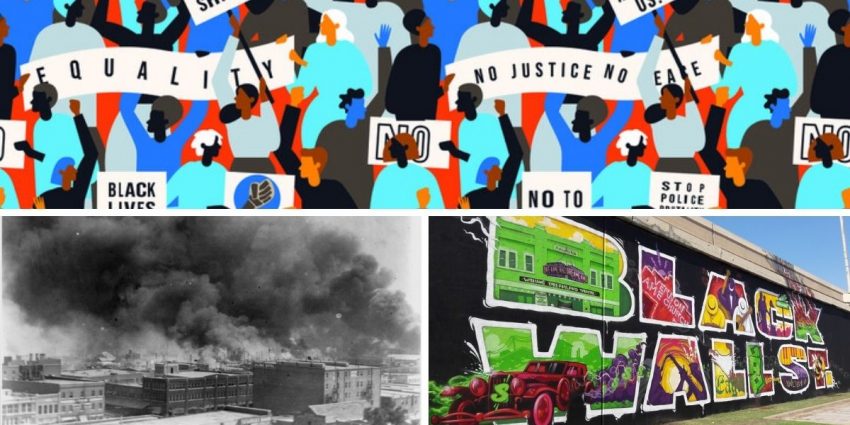Hi there! You new here? We love that you found our gay little corner of the web. Here at Debt Free Guys, we’re all about helping queer people live lives they truly love inside and out. We think happiness is a 360-degree experience (purpose, love, money, wellness, and lifestyle) that you also deserve. After reading our article below, see how we can help you more here.
The massacre at Black Wall Street
If you’re like most people, you didn’t learn about the massacre at Black Wall Street in 1921. That’s cause it’s a part of our history many would rather forget . . . but here’s why we shouldn’t.
Hear the authority of Black Wall Street, Hannibal B. Johnson, on Queer Money®:
Hannibal B. Johnson on Tulsa’s Greenwood District, Black Wall Street
At least 300 people were killed and hundreds injured in the Tulsa Race Riot of 1921. 1,250 homes, businesses and schools were burned, resulting in $2M of property damage (equivalent to more than $25M today). Tulsa’s Greenwood District, affectionately known as Black Wall Street, was destroyed by a mob of thousands of white men. So, why are so few Americans aware of this history? Hannibal B. Johnson is an attorney, activist and independent consultant with expertise in diversity, inclusion and cultural competence. He serves on the federal 400 Years of African American History Commission and chairs the Education Committee for the 1921 Tulsa Race Massacre Centennial Commission. Hannibal is also the author of many books, including Black Wall Street: From Riot to Renaissance in Tulsa’s Historic Greenwood District and Black Wall Street 100: An American City Grapples with Its Historical Racial Trauma. On this episode of Queer Money®, Hannibal joins us to explain what Tulsa was like in the early twentieth century and describe the entrepreneurial spirit of the Black community in its Greenwood District. He walks us through the events surrounding the Tulsa Race Riot of 1921, discussing what triggered the burning of Black Wall Street and how the African American community went on to rebuild. Listen in to understand how our history of systemic racism informs the current wealth gap and learn how YOU can help Hannibal build awareness of what happened in Tulsa 100 years ago. 
Topics covered on Black Wall Street
What inspired Hannibal about the history of Black Wall Street
• Important to tell history from the perspective of a Black person living in Tulsa • Focus on community and individuals who created and sustained it
What Tulsa’s Greenwood District was like in the early twentieth century
• Thriving small business and an entrepreneurial enclave of the Black community • Message of empowerment and affirmation saw limitless possibilities
The cognitive dissonance that fueled the Tulsa Race Riot of 1921
• White supremacy was the norm, but they saw the thriving, wealthy Black community • Whites saw the need to ‘right the ship’ (especially those not doing as well)
What you need to know about the context of the Tulsa Race Riot of 1921
• Red Summer of 1919, assaults on Black communities across US • Nearly 5,000 lynchings between 1877 and 1965
The timeline of events around the burning of Black Wall Street
• Black boy bumped into white girl on an elevator and was jailed for assault • White mob of thousands overrun community to ‘loot, shoot and set on fire’ • 100 to 300 killed, $2M in property damage and 1,250 homes destroyed • 10,000 African Americans remained and rebuilt the community
How our history of systemic racism informs the wealth gap in the US
• No way to build assets when working for no wages as slaves • Well-off Blacks had entire wealth destroyed, could not pass down
Why race riots quelled the entrepreneurial spirit of many African Americans
• Difficult to plan for future so uncertain • Wealth represented a threat to powers that be
Hannibal’s insight around the Ku Klux Klan
• Vigilante group of domestic terrorists • Mission to intimidate Blacks, remind of place in society
How Hannibal thinks about the importance of allies from other communities
• Goal of centennial commission to achieve reconciliation • Building relationships requires giving people grace
Why the history of the Tulsa Race Riot of 1921 was buried for so long
• Minimized for sake of the city’s reputation, shame and blame among whites • Black community feared recurrence and didn’t want to burden children
What the centennial commission is doing to build awareness around Tulsa’s history
• Developing curriculum to ensure history is taught in Oklahoma schools • Teacher Institute to share pedagogy with educators
Hannibal’s take on the expansion of diversity, equity and inclusion
• Expansion leads to backlash as some feel power/privilege slip away • Come together around shared humanity where all valued and respected [click_to_tweet tweet=”“In the face of pretty crass and gross systemic racism, the human spirit ultimately prevailed.” – Hannibal B. Johnson” quote=”“In the face of pretty crass and gross systemic racism, the human spirit ultimately prevailed.” – Hannibal B. Johnson” theme=”style3″]
Connect with Hannibal B. Johnson
Resources on the massacre at Black Wall Street
- Black Wall Street: From Riot to Renaissance in Tulsa’s Historic Greenwood District by Hannibal B. Johnson
- Black Wall Street 100: An American City Grapples with Its Historical Racial Trauma by Hannibal B. Johnson
- A People’s History of the United States by Howard Zinn
- Death in a Promised Land: The Tulsa Race Riot of 1921 by Scott Ellsworth
- Greenwood Rising
- Debt Free Guys on Facebook
- Debt Free Guys on Twitter
- Queer Money Facebook Group
- Queer Money on Instagram
- Subscribe on iTunes
- Email [email protected]

